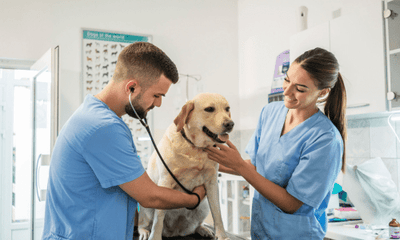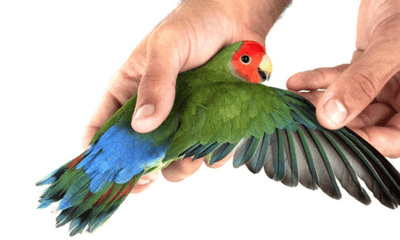We’ve all heard the saying ‘you can’t teach an old dog new tricks’, but is this actually true or just a myth? There is no denying that puppies' brains soak up new information like sponges and they learn very quickly. But, while it takes a little longer, you can train an adult dog. Our pet experts have put together our top tips on how to train your adult dog!
With the right training approach, any dog can learn. Dogs are lifelong learners, and love to please their owners and receive attention. An older dog may take a little longer to understand what you’re trying to achieve since their habits are more ingrained. But, once they realise that it’s an opportunity to please you and spend more time with you, they will more than likely be willing to cooperate. Older dogs can be trained to sit, stay, high five, shake hands, retrieve objects and much more. Not only is it totally possible to train your older dog, but it brings a range of benefits for both you and your pet.
Benefits of training an older dog
- Keeps your dog mentally and physically stimulated
- Corrects bad behaviours that may have been developed
- A great way to bond and spend time with your dog
- Having a well trained dog is important for your safety and the safety of other dogs and people
- Improves dog’s manners and overall temperament
- Prevents bad habits forming
- Helps slow cognitive decline
Our top tips on how to train your older dog
To successfully train your older dog, you can’t do it randomly or spontaneously, you need an organised and structured training plan. Don’t expect to follow the same training plan that you may have used for younger dogs. Each dog is unique, so the training plan must be customised.
Establish what your dog already knows
If you have newly adopted an adult or senior dog, the first thing you need to do before you begin training is establish what they already know. Pay attention to their bathroom habits, whether they have general household manners, and if they respond to any basic commands such as sit, stay and come. Use their current knowledge as a starting point for training.
Untrain old habits before training new habits
Throughout their lifetime, dogs can pick up lots of bad habits, especially if they have had no training. It is important to recognize that before you can teach your adult dog what you want them to do, you may have to teach them to stop doing what you don’t want them to do. You will need to use positive reinforcement to get them to abandon these habits, and replace them with constructive behaviours. For example, if your dog loves to chew on shoes and clothes, you could provide him with a range of dog-friendly chew toys to chew on instead, teaching him that he can get the same positive reaction by following this new desired behaviour.
Use positive reinforcement, always
Positive reinforcement training involves giving your dog something positive immediately after a certain behaviour, with the aim of increasing the frequency of that behaviour. It is important to use positive reinforcement and praise to train your adult dog. Your dog seeks your love and approval, so they will respond best to positive feedback as a reward when they get it right. No form of punishment should be used when your dog makes a mistake. Instead, use treats and positive reinforcement to redirect your dog’s behaviour and reinforce the desired action.
Be patient and stay calm
It is important to always use patience and a calm temperament with your dog, even when they do get it wrong. With enough patience, they will eventually figure it out as long as you maintain a positive attitude that motivates them to do their best. Remember that not all dogs have the same attention span, so if you feel your dog is getting easily distracted, perhaps try shortening the training sessions.
Break it down into simple steps
Most dogs should have no trouble learning a simple task, so instead of overwhelming them with a big and difficult task, break it down into steps. Simply teach them to follow one simple step at a time. Once they have learned each simple step, you may string the steps together in order to accomplish a more complex task. You may like to reward them with a treat after each step to keep them keen and motivated.
Set realistic goals
Rome wasn’t built in a day! While it would be great for your dog to pick up every new behaviour instantly, this won’t always be the case. Depending on your dog’s background, some behaviours may be harder to teach than others. For example, if your dog was trained to go to the toilet in a specific spot inside, and now you’re training them to go outside, it may take a while for them to get their head around the change in environment. Expect progress to be slow, and use small, realistic goals to keep motivated.
Stick to a routine
It is a good idea to feed, train and exercise your dog at the same time everyday where possible, so they can establish a routine. Having a routine means they know what to expect, and they will be ready to learn when you need them to. Consistency in time, frequency and location works wonders when training older dogs.
Short and sweet
Try not to overwhelm your dog with long and strenuous training sessions that leave them feeling mentally and physically exhausted. Keep it short and simple by limiting your dog training sessions to 10-20 minutes at a time. Start with simple commands such as sit and stay.
Avoid distractions
When choosing an appropriate place to conduct your training, it may be a good idea to choose somewhere with minimal distractions to help speed up the training process. Rather than a local park where there are going to be other dogs and people, perhaps use a quiet and safe environment such as your backyard.
Keep it fun
When done correctly, dog training can be one of the most fun and interactive ways to bond with your dog! Be imaginative, and try lots of different ways to encourage the desired behaviour. Dog training should never be boring. Adult dogs cannot be forced to learn, they have been around for long enough to develop their own ideas about appropriate behaviour, so they will only be willing to learn new behaviours if you convince them it’s a fun idea!
Seek professional help
It is always a good idea to reach out and seek expert assistance if you are struggling or feeling overwhelmed by the training process. Not only will your dog learn a lot during obedience classes, but you will too, and it can be a great bonding experience! Experienced dog trainers can teach techniques and methods that produce results.
We hope these tips help to make training your adult dog a success! Dog training isn’t always easy, but it is a wonderful way to establish trust and build a bond. Age is never a reason to pass on trying to train a dog. Their potential to learn may decrease as they get older, but their desire to please their humans is something they will carry with them forever. Dog training benefits not only your dog, but you as well, because it will help you build a better relationship with your furry companion.






